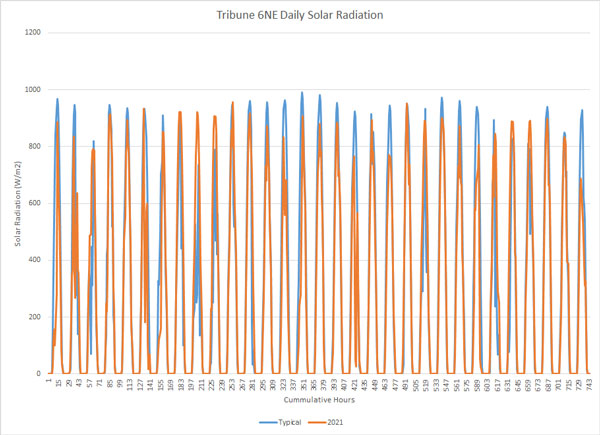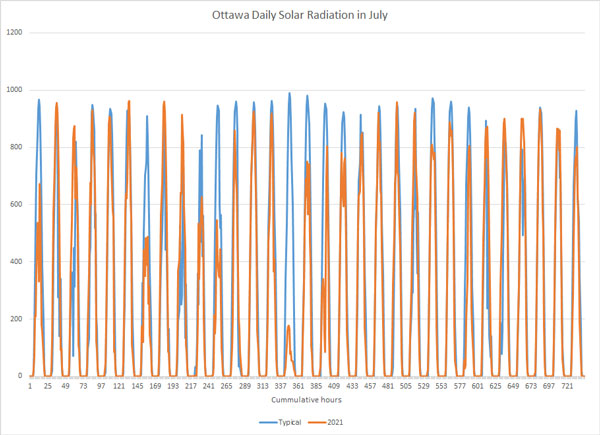Corn farmers are reporting concerns as the crop is approaching maturity. One of the main issues is about the premature ear droop observed in several fields across the state. Corn plants typically maintain the ears in the upright position until after the crop has reached full maturity (black layer - around 35% grain moisture in the kernels). This process occurs due to the loss of turgidity in the shank that supports the ear (Figure 1). This condition observed in several fields across the state is a reflection that the movement of sugars and nutrients from the plant to the ear has been impaired and therefore grain filling is usually interrupted.

Figure 1. Droopy ears observed in a cornfield and a picture of the ear depicting kernels early in the grain filling process. Photos by Marvin Pipes.
The main consequence of this phenomenon is that all kernels in the ear will move prematurely to black layer formation (maturity) (Figure 2). This issue will have a larger impact on yield depending on the stage of the grain filling – with earlier occurrences during the grain filling presenting a larger impact on final yields, primarily by affecting the final kernel size.
Factors that influence droopy ears
Some of the conditions that favor this issue are related to: high temperatures, poor root development, and drought stress – with the latter as one of the most relevant factors in past seasons. However, it does not appear that drought was the main cause for this season since this issue has also being reported in many irrigated fields where water is not a limiting factor. At this point, we are still exploring different hypotheses for main causes. However, one certainty is the loss of turgidity in the shank is linked to a cannibalization of carbohydrates for the plant. Simply put, the plants (more specifically, the kernels) were running out of resources. When this occurs, the plant will use all the reservoirs of carbohydrates available – with the stem and shank organs as main plant storage units – until running out of sugars to satisfy the grain-filling demand.
A few factors that can affect the ability of the plant to produce fewer carbohydrates (and also have a low reservoir) are linked to the photosynthesis process. Optimal temperature, solar radiation, adequate water, and nutrition are key components for healthy plants and good conditions for improving the ability to produce carbohydrates. Many factors are still under evaluation. Based on our current analysis, there is clearly a combination of multiple stresses (less optimal temperatures, cloudy days, and high evapotranspiration) affecting photosynthesis and thus the capability of the corn plants to satisfy the demand coming from all the kernels in the ear.

Figure 2. Corn at dent and black layer growth stages (upper panel) and progression of “milk line” for corn (lower panel; source: https://bookstore.ksre.ksu.edu/pubs/MF3305.pdf). Photo and infographic by Ignacio Ciampitti, K-State Research and Extension.
Another potential cause for 2021 season could be the smoke coverage from western wildfires (Figure 3). Overall, when looking at a few locations in Kansas, a very small reduction of incoming solar radiation for the last month was observed, potentially reducing the potential yield (Figure 4). Lastly, adding the effect of high temperatures and lack of precipitation combined with this stress can make an impact on the ability of the plant to sustain the filling of all kernels and to maintain yields.

Figure 3. July 23, 2021 smoke coverage across the US. Source: NASA Earth observatory, https://earthobservatory.nasa.gov/images/148610/smoke-across-north-america


Figure 4. Comparison of 2021 solar radiation (orange) to typical (blue) during July (shown as cumulative hours from July 1 to July 31) at Tribune 6NE (top graph) and Ottawa 2SE (bottom graph). Source: Kansas Mesonet and the National Solar Radiation Database.
What is the impact on final yield?
Yield impact will depend on the timing of stress. From early dent stage to physiological maturity, the overall duration of grain filling is around 33 days (depending on environmental and plant factors; Table 1).
- If the stress takes place early during the dent stage (R5 stage), the final dry matter in the kernel is only at about 45% (kernels with 60% moisture).
- If the stress occurs a week after the onset of dent stage (R5.25 stage), the kernel moisture is usually at around 50%, with + 30% of dry matter still to be accumulated until maturity.
- If the stress occurs at mid-point of dent stage (1-2 weeks after early dent; R5.5 stage) or late dent (2-3 weeks after early dent; R5.75), then the overall impact on dry matter accumulation until maturity will be relatively small, ranging from 3-10%.
Table 1. Growth stages, moisture content, and total dry matter progression for corn from late to physiological maturity. Table from K-State Research and Extension publication MF3305 (Ciampitti, Elmore, Lauer, 2016).

The timing of stress influences the final accumulation of dry matter, affecting kernel size. Common values range of kernels per bushel range from 75,000 to 80,000 for favorable, 85,000 to 90,000 for average, and 95,000 to 105,000 for poor grain filling conditions. An example of the potential impacts for extreme cases (average vs. favorable filling) is presented below, but these estimations depend on the total number of ears affected by this issue.
Example:
Ears per acre: (30-inch rows), 24,000 ears per acre
Kernels per ear = 650 kernels;
Kernels per acre = 15,600,000 kernels per acre
Kernels per bushel:
- Average filling = 15,600,000 kernels per acre ÷ 90,000 kernels per bushel = 173 bu/acre
- Favorable filling = 15,600,000 kernels per acre ÷ 80,000 kernels per bushel = 195 bu/acre
At this point, scouting fields will be important in order to check for the integrity of the ear shanks and to explore potential issues affecting harvest operations (e.g., presence of ears on the ground).
Ignacio A. Ciampitti, Farming Systems
ciampitti@ksu.edu
Mary Knapp, Assistant State Climatologist
mknapp@ksu.edu
Christopher “Chip” Redmond, Kansas Mesonet Manager
christopherredmond@ksu.edu